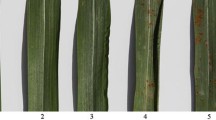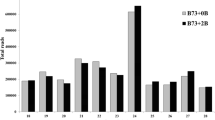Abstract
Understanding the molecular organization of the maize B-chromosome is hindered by its high homology with A-chromosomes. Recently, various approaches have been employed to overcome this hindrance, and several B-chromosome-specific sequences have been identified. Here, we cloned and characterized four previously published B-chromosome-specific RAPD fragments in detail. The results of sequence analysis, Southern hybridization and fluorescence in situ hybridization revealed that the four RAPD fragments are repetitive and present on both the B- and A-chromosomes, which supports an A-chromosome origin of the B-chromosome. We further developed four sequence-characterized amplified region (SCAR) markers derived from the four B-chromosome-specific RAPDs. These markers amplified PCR products exclusively in plants with B-chromosomes and were further mapped to definite distal heterochromatic regions of the B-chromosome by 15 B–A translocations. Furthermore, reverse transcriptase-PCR revealed that two of the four B-chromosome-specific RAPD fragments are transcriptionally active. These results demonstrate the feasibility of using B-chromosome-specific RAPD sequences to generate SCAR markers specific to the B-chromosome and might apply to other sequences of the maize B-chromosome.







Similar content being viewed by others
References
Alfenito MR, Birchler JA (1993) Molecular characterization of a maize B chromosome centric sequence. Genetics 135:589–597
Banael-Moghaddam AM, Meier K, Karami-Ashtiyani R, Houben A (2013) Formation and expression of pseudogenes on the B chromosome of rye. Plant Cell 25:2536–2544
Carchilan M, Kumke K, Mikolajewski S, Houben A (2009) Rye B chromosomes are weakly transcribed and might alter the transcriptional activity of A chromosome sequences. Chromosoma 118:607–616
Cha TS, Anne-Marie K, Chuah TS (2014) Identification and characterization of RAPD–SCAR markers linked to glyphosate-susceptible and -resistant biotypes of Eleusine indica (L.) Gawetn. Mol Biol Rep 41:823–831
Cheng YM (2010) Evolution of the heterochromatic regions on maize B long arm based on the sequence structure of CL-repeat variants. Chromosome Res 18:605–619
Cheng YM, Lin BY (2003) Cloning and characterization of maize B chromosome sequences derived from microdissection. Genetics 164:299–310
Cheng YM, Lin BY (2004) Molecular organization of large fragments of maize B chromosome: indication of a novel repeat. Genetics 166:1947–1961
Chilton MD, McCarthy BJ (1973) DNA from maize with and without B chromosomes: a comparative study. Genetics 74:605–614
Heun M, Helentjaris T (1993) Inheritance of RAPDs in F1 hybrids of corn. Theor Appl Genet 85:961–968
Hou H, Conner JA, Ozias-Akins P (2009) Genetic mapping of the apospory-specific genomic region in Pennisetum squamulatum using retrotransposon-base molecular markers. Theor Appl Genet 119:119–212
Jamilena M, Garrido-Ramos M, Ruiz Rejón M, Ruiz Rejón C, Parker JS (1995) Characterization of repeated sequences from microdissected B-chromosome of Crepis capillaries. Chromosoma 104:113–120
Jones RN, Rees H (1982) B chromosomes. Academic Press, London
Jones CJ, Edwards KJ, Castaglione S, Winfield MO, Sala F, van de Wiel C, Bredemeijer G, Vosman B, Matthes M, Daly A, Brettschneider R, Bettini P, Buiatti M, Maestri E, Malcevschi A, Marmiroli N, Aert R, Volckaert G, Rueda J, Linacero R, Vazquez A, Karp A (1997) Reproducibility testing of RAPD, AFLP and SSR markers in plants by a network of European laboratories. Mol Breed 3:381–390
Jones RN, Viegas W, Houben A (2008) A century of B chromosomes in plants: so what? Ann Bot 101:767–775
Kuwada Y (1915) Ueber die Chromosomenzahl von Zea mays L. Bot Mag Tokoyo 29:83–89
Lamb JC, Kato A, Birchler JA (2005) Sequences associated with A chromosome centromeres are present throughout the maize B chromosome. Chromosoma 113:337–349
Lamb JC, Riddle NC, Cheng YM, Theuri J, Birchler JA (2007) Localization and transcription of a retrotransposon-derived element on the maize B chromosome. Chromosome Res 15:383–398
Li B, Li N, Duan XG, Wei A, Yang A, Zhang J (2010) Generation of marker-free transgenic maize with improved salt tolerance using the FLP/FRT recombination system. J Biotechnol 145:206–213
Lin BY, Chou HP (1997) Physical mapping of four RAPDs in the B-chromosome of maize. Theor Appl Genet 94:534–538
Lin BY, Peng SF, Chen YJ, Chen HS, Kao CF (1997) Physical mapping of RFLP markers on four chromosome arms in maize using terminal deficiencies. Mol Gen Genet 256:509–516
Lin HZ, Lin WD, Lin CY, Peng SF, Cheng YM (2014) Characterization of maize B-chromosome-related transcripts isolated via cDNA-AFLP. Chromosoma. doi:10.1007/s00412-014-0476-7
Lo KL, Lin YP, Chen LJ, Lin BY (2009a) Isolation and characterization of new maize B sequences from a microdissected library. Plant Mol Biol Rep 27:350–354
Lo KL, Peng SF, Chen LJ, Lin BY (2009b) Tandem organization of StarkB element (22.8 kb) in the maize B chromosome. Mol Genet Genomics 282:131–139
Martis MM, Klemme S, Banaei-Moghaddam AM, Blattner FR, Macas J, Schmutzer T, Scholz U, Gundlach H, Wicker T, Šimková H, Novák P, Neumann P, Kubaláková M, Bauer E, Haseneyer G, Fuchs J, Doležel J, Stein N, Mayer KF, Houben A (2012) Selfish supernumerary chromosome reveals its origin as a mosaic of host genome and organellar sequences. Proc Natl Acad Sci USA 103:13343–13346
Muñoz-Pajares AJ, Martínez-Rodríguez L, Teruel M, Cabrero J, Camacho JP, Perfectti F (2011) A single, recent origin of the accessory B chromosome of the grasshopper Eyprepocnemic plorans. Genetics 187:853–863
Oyama RK, Volz SM, Renner SS (2009) A sex-linked SCAR marker in Bryonia dioica (Cucurbitaceae), a dioecious species with XY sex-determination and homomorphic sex chromosomes. J Evol Biol 22:214–224
Page BT, Wanous MK, Birchler JA (2001) Characterization of a maize chromosome 4 centromeric sequence: evidence for an evolutionary relationship with the B chromosome centromere. Genetics 159:291–302
Paran I, Michelmore RW (1993) Development of reliable PCR-based markers linked to downy mildew resistance genes in lettuce. Theor Appl Genet 85:985–993
Peng SF, Cheng YM (2011) Characterization of satellite CentC repeats from heterochromatic regions on the long arm of maize B-chromosome. Chromosome Res 19:183–191
Peng SF, Lin YP, Lin BY (2005) Characterization of AFLP sequences from regions of maize B chromosome defined by 12 B-10L translocations. Genetics 169:375–388
Penner GA, Bush A, Wise R, Kim W, Domier L, Kasha K, Laroche A, Scoles G, Molnar SJ, Fedak G (1993) Reproducibility of random amplified polymorphic DNA (RAPD) analysis among laboratories. Genome Res 2:341–345
Pereira HS, Barão A, Caperta A, Rocha J, Viegas W, Delgado M (2009) Rye Bs disclose ancestral sequences in cereal genomes with a potential role in gametophyte chromatid segregation. Mol Bio Evol 26:1683–1697
Ruiz-Estévez M, López-León MD, Cabrero J, Camacho JPM (2012) B-chromosome ribosomal DNA is functional in the grasshopper Eyprepocnemis plorans. PLoS One 7:e36600
Stark EA, Connerton I, Bennett ST, Barnes SR, Parker JS, Forster JW (1996) Molecular analysis of the structure of the maize B-chromosome. Chromosome Res 4:15–23
Tosta VC, Fernandes-Salomão TM, Tavares MG, Pompolo SG, Barros EG, Campos LA (2004) A RAPD marker associated with B chromosomes in Partamona helleri (Hymenoptera, Apidae). Cytogene Genome Res 106:279–283
Tosta VC, Tavares MG, Fernandes-Salomão TM, Barros EG, Campos LA, Camacho JP (2007) Development of a SCAR marker for the analysis of B chromosome presence in Partamona helleri (Hymenoptera, Apidae). Cytogene Genome Res 116:127–129
Trifonov VA, Dementyeva PV, Larkin DM, O’Brien PC, Perelman PL, Yang F, Ferguson-Smith MA, Graphodatsky AS (2013) Transcription of a protein-coding gene on B chromosomes of the Siberian roe deer (Capreolus pygargus). BMC Biol 11:90
Xin GZ, Lam YC, Maiwulanjiang M, Chan GK, Zhu KY, Tang WL, Dong TT, Shi ZQ, Li P, Tsim KW (2014) Authentication of Bulbus Fritillariae Cirrhosae by RAPD-derived DNA markers. Molecules 19:3450–3459
Zhou Q, Zhu HM, Huang QF, Zhao L, Zhang GJ, Roy SW, Vicoso B, Xuan ZL, Ruan J, Zhang Y, Zhao RP, Ye C, Zhang XQ, Wang J, Wang W, Bachtrog D (2012) Deciphering neo-sex and B chromosome evolution by the draft genome of Drosophila albomicans. BMC Genomics 13:109
Acknowledgments
This work was supported by the National Sciences Council Grant of Taiwan (NSC99-2311-B-005-003-MY3 and NSC102-2311-B-005-001-).
Author information
Authors and Affiliations
Corresponding author
Additional information
Communicated by S. Hohmann.
K.-W. Kao and C.-Y. Lin contributed equally to this work.
Electronic supplementary material
Below is the link to the electronic supplementary material.
438_2014_926_MOESM1_ESM.docx
Supplementary material 1 Supplementary Fig. 1 Breakpoints of 15 B–A translocations on the maize B-chromosome. The breakpoints of the TB-1La, TB-3Sb, TB-4Sa, TB-7Lb, and 11 B-10L translocations (TB-10L) are indicated by arrows. BS, B-chromosome short arm; CK, centromere and centromeric knob; PE, proximal euchromatin; DH1–DH4, four distal heterochromatins; DE, distal euchromatin (DOCX 15 kb)
438_2014_926_MOESM2_ESM.tif
Supplementary material 2 Supplementary Fig. 2 Binding sites of SCAR primers on the four B-chromosome-specific RAPDs. The hollow arrows indicate the SCAR primer-binding sites (TIFF 182 kb)
438_2014_926_MOESM3_ESM.tif
Supplementary material 3 Supplementary Fig. 3 Amplification of B-chromosome-specific fragments using four RAPD primers. Genomic DNA from L289+0B (0B) and L289+1B (1B) was used to amplify B-chromosome-specific DNA fragments (arrows) using four RAPD primers: UBC313 (a), UBC345 (b), UBC349 (c), and UBC426 (d). M, molecular weight marker (molecular weights shown at left) (TIFF 215 kb)
438_2014_926_MOESM4_ESM.tif
Supplementary material 4 Supplementary Fig. 4 Screening of B-chromosome-specific SCAR primer combinations. Genomic DNA from L289+0B (lane 1), L289+1B (lane 2), W23+0B (lane 3), and W23+1B (lane 4) was used to amplify B-chromosome-specific fragments (arrows) using the SCAR primer combinations 313-F1/313-R1 (a), 313-F2/313-R1 (b), 313-F3/313-R1 (c), 345-F1/345-R1 (d), 345-F1/345-R2 (e), 349-F1/349-R1 (f), 349-F2/349-R1 (g), 349-F2/349-R2 (h), 426-F1/426-R1 (i), 426-F1/426-R2 (j), 426-F1/426-R3 (k), 426-F2/426-R1 (l), 426-F2/426-R2 (m), and 426-F2/426-R3 (n). M, molecular weight marker (molecular weights are shown at left) (TIFF 1576 kb)
Rights and permissions
About this article
Cite this article
Kao, KW., Lin, CY., Peng, SF. et al. Characterization of four B-chromosome-specific RAPDs and the development of SCAR markers on the maize B-chromosome. Mol Genet Genomics 290, 431–441 (2015). https://doi.org/10.1007/s00438-014-0926-1
Received:
Accepted:
Published:
Issue Date:
DOI: https://doi.org/10.1007/s00438-014-0926-1




